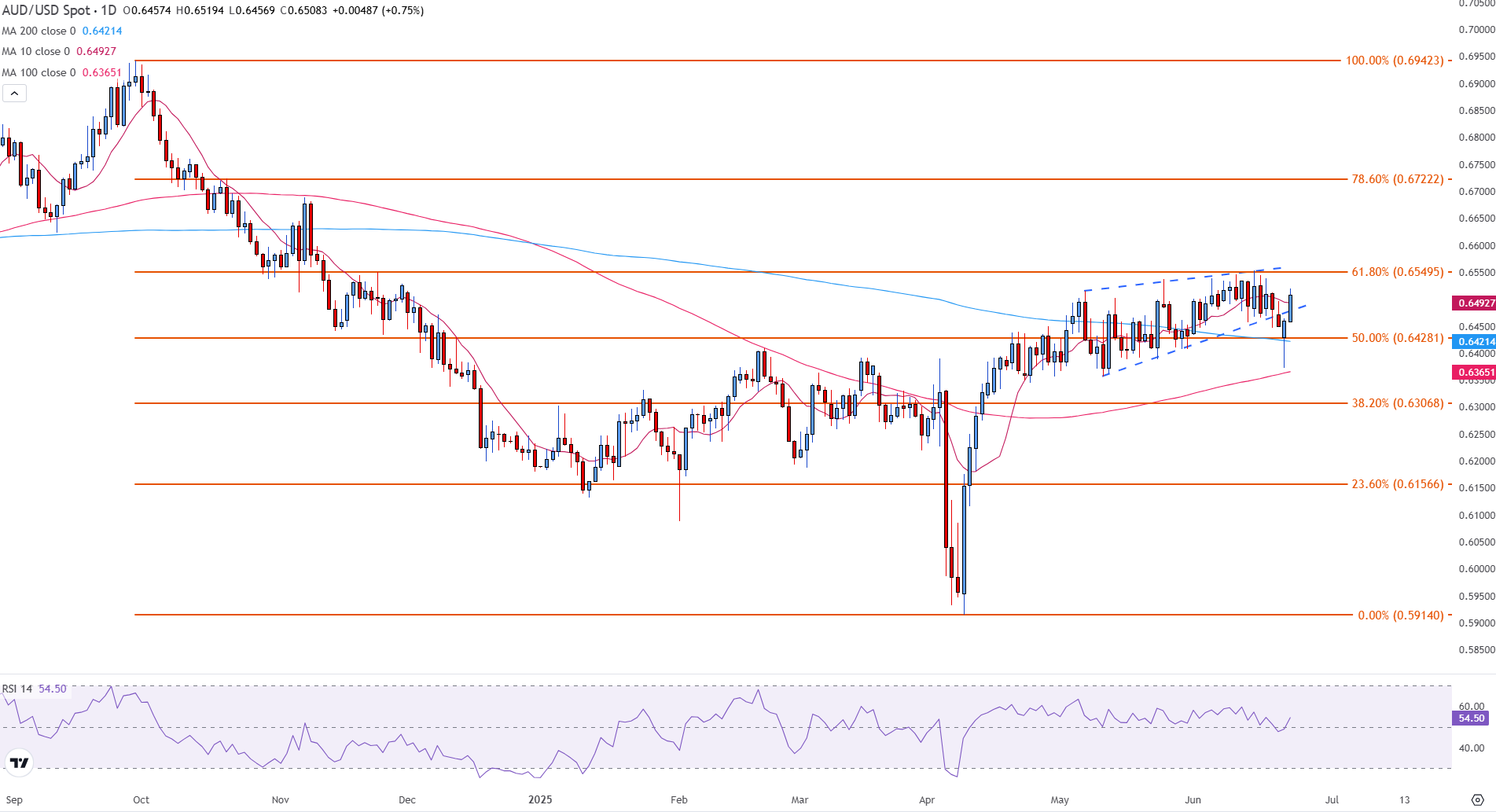AUD/USD extends gains as tensions in the Middle East overshadow Fed Powell's hawkish comments
- AUD/USD extends its recovery above 0.6500 as easing tensions in the Middle East reduce demand for the safe-haven US Dollar.
- Fed Chair Jerome Powell reiterates a data-driven approach on his testimony to Congress, but his hawkish remarks fail to lift the Greenback.
- Risk sentiment improves following Israel–Iran ceasefire, lifting AUD/USD back into the confines of a rising wedge pattern on the daily chart.
The Australian Dollar (AUD) continues to strengthen against the United States Dollar (USD) on Tuesday as traders react to signs of easing geopolitical tensions.
Reports confirming a ceasefire between Israel and Iran have helped calm market nerves, prompting a shift back into risk-sensitive assets.
At the time of writing, AUD/USD is trading above the 0.6500 handle, buoyed by fading demand for traditional safe-haven assets, such as the US Dollar.
In Washington, Federal Reserve (Fed) Chair Jerome Powell began his two-day testimony before Congress. His tone remained broadly consistent with recent commentary, emphasizing a data-driven approach while acknowledging progress on inflation.
Powell reiterated that the Fed is not in a rush to lower interest rates, although the door remains open if incoming data supports such a move.
AUD/USD rises above 0.6500, trading within the confines of the rising wedge
After breaching the lower boundary of the rising wedge formation on Monday, AUD/USD found support near the 200-day Simple Moving Average (SMA) at 0.6420.
Since then, the pair has climbed back within its rising wedge formation on the daily chart. With AUD/USD prices currently trading above the psychological support level of 0.6500, the next level to watch is resistance at 0.6549.
This aligns with the 61.8% Fibonacci retracement of the September-April decline, which has capped the upside gains for AUD/USD throughout the month.
AUD/USD daily chart

A confirmed breakout above this area would open the door toward 0.6700, the next zone of psychological resistance.
In contrast, a move below 0.6500 could see prices pull back toward the 200-day SMA near 0.6420 and toward 0.6400. Below that, the 100-day SMA may provide additional support at a level of 0.6365.
With the Relative Strength Index (RSI) currently near 54, momentum is trading with a slightly bullish bias, above the neutral zone of 50.
Markets will keep a close eye on Powell’s second round of testimony on Wednesday. However, unless there is a shift in tone or unexpected economic data, geopolitical calm is likely to remain a key driver of AUD/USD in the short term.
Australian Dollar FAQs
One of the most significant factors for the Australian Dollar (AUD) is the level of interest rates set by the Reserve Bank of Australia (RBA). Because Australia is a resource-rich country another key driver is the price of its biggest export, Iron Ore. The health of the Chinese economy, its largest trading partner, is a factor, as well as inflation in Australia, its growth rate and Trade Balance. Market sentiment – whether investors are taking on more risky assets (risk-on) or seeking safe-havens (risk-off) – is also a factor, with risk-on positive for AUD.
The Reserve Bank of Australia (RBA) influences the Australian Dollar (AUD) by setting the level of interest rates that Australian banks can lend to each other. This influences the level of interest rates in the economy as a whole. The main goal of the RBA is to maintain a stable inflation rate of 2-3% by adjusting interest rates up or down. Relatively high interest rates compared to other major central banks support the AUD, and the opposite for relatively low. The RBA can also use quantitative easing and tightening to influence credit conditions, with the former AUD-negative and the latter AUD-positive.
China is Australia’s largest trading partner so the health of the Chinese economy is a major influence on the value of the Australian Dollar (AUD). When the Chinese economy is doing well it purchases more raw materials, goods and services from Australia, lifting demand for the AUD, and pushing up its value. The opposite is the case when the Chinese economy is not growing as fast as expected. Positive or negative surprises in Chinese growth data, therefore, often have a direct impact on the Australian Dollar and its pairs.
Iron Ore is Australia’s largest export, accounting for $118 billion a year according to data from 2021, with China as its primary destination. The price of Iron Ore, therefore, can be a driver of the Australian Dollar. Generally, if the price of Iron Ore rises, AUD also goes up, as aggregate demand for the currency increases. The opposite is the case if the price of Iron Ore falls. Higher Iron Ore prices also tend to result in a greater likelihood of a positive Trade Balance for Australia, which is also positive of the AUD.
The Trade Balance, which is the difference between what a country earns from its exports versus what it pays for its imports, is another factor that can influence the value of the Australian Dollar. If Australia produces highly sought after exports, then its currency will gain in value purely from the surplus demand created from foreign buyers seeking to purchase its exports versus what it spends to purchase imports. Therefore, a positive net Trade Balance strengthens the AUD, with the opposite effect if the Trade Balance is negative.
